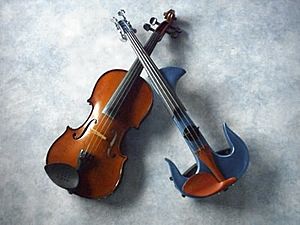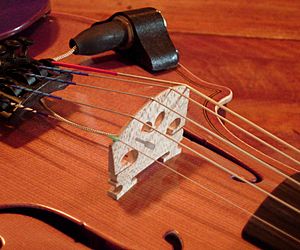Electric violin facts for kids
An electric violin is a string instrument that you play with a bow, just like a regular violin. Its strings are usually tuned to the notes G, D, A, and E. But because it's electric, you can change its sound in many ways! You hold it between your left collar bone (near your shoulder) and your chin.
To make different notes, you press down on the strings with your left hand. At the same time, you move the bow with your right hand. Unlike a guitar, an electric violin has no frets or markers. Players must learn exactly where to place their fingers. People who build and fix violins, called Luthiers, also work on electric violins.
Modern electric violins have been around for about 10 years. But similar string instruments have existed for almost 1,000 years! The electric violin became very popular, much like the electric bass. You can hear it played alone, in rock bands, and sometimes in blues music. It's also used in folk music.
Electric violins often look different from regular violins. They come in cool, wacky shapes and bright colors!
Contents
History of Electric Violins
People have used electric violins, or at least violins with added sound, since the 1920s. A jazz and blues musician named Stuff Smith is often said to be one of the first to add pickups and amplifiers to violins. Companies like Electro Stringed Instrument Corporation, National, and Vega sold electric violins in the 1930s and 1940s. Even Fender made a few in the late 1950s. Since the 1990s, many well-known companies and new makers have found great success selling electric violins.
What an Electric Violin Is Like
Regular violins can be made electric by adding a piezoelectric pickup to the bridge or body. You can also attach a magnetic pickup near the fingerboard. Another way is to put an electrodynamic pickup under the fingerboard. This avoids changing the violin's natural sound.
To stop loud feedback on stage, many electric violins have a solid body. This is different from the hollow body of a regular violin. The natural sound of a regular violin comes from its hollow body. So, an electric violin might have a "rawer" or "sharper" sound. This sound is often liked in rock, pop, and some experimental music. Some designs are "semi-hollow." They have a sealed, hollow space inside. This helps them sound a bit more like an acoustic violin while still reducing feedback.
Solid-body electric violins often have a simple, minimalistic design. This helps keep them light. New materials like kevlar, glass, and carbon fibers are now used to build them.
Electric violins are sometimes seen as "experimental" instruments. They are not as common as electric guitars or basses. Because of this, there are many different designs. Some have frets, like a guitar. Others have extra strings or machine heads (tuning pegs). Some have "baritone" strings that sound an octave lower. There are even violins with sympathetic strings that vibrate on their own. For example, luthier Yuri Landman built a 12-string electric violin for the band DAAU. Its strings are grouped in fours, all tuned the same, to create a fuller sound. It also has an extra pickup in the tailpiece for more sound from the vibrating strings.
Acoustic violins with 5 strings are becoming more common. It's not unusual for an electric violin to have 5, 6, 7, or even more strings. The solid body can handle the extra tension from more strings easily. A 5-string violin usually adds a low C string. A 6-string adds a low C and a low F. A 7-string adds a low C, F, and B♭.
Electric violin sounds often go through electronic effects. This is similar to how an electric guitar works. These effects can include delay, reverb, chorus, or distortion.
Today, electric violins are even helping make music education exciting. For example, Mark Wood was featured on Today for his "music camp that combines rock and orchestra." He uses rock performances with electric violins to bring new interest to music. Money from these events goes to school music programs. Today said this mix of classical and rock music gives kids a new love for music.
How Pickups Work
Electric violins can use magnetic, piezoelectric, or electrodynamic pickups. Magnetic pickups, like those on guitars, need violin strings that contain iron, like steel. There are a few single-coil guitar-style magnetic systems available. The small size of a violin and its curved strings limit where coils can be placed.
One special system uses the string itself as a pickup. It fits standard acoustic violins. The only rule is that the string must conduct electricity, so common synthetic or steel core strings work well.
Generally, piezoelectric pickups are cheaper and more common. These pickups are often ceramic discs, cylinders, or plastic films. They sense physical vibrations directly. Sometimes they are placed in or on the violin's body. More often, they sense vibrations from the bridge. Some setups have a separate pickup under each string within the bridge. A few systems use pickups that can tell the difference between bowing and plucking. You can then choose which sound mode you prefer with a switch.
Amplifying Your Electric Violin
Making an electric violin louder is much like making an electric guitar louder. Both produce an audio signal that travels through a cable to an amplifier or PA system. Because of this, there are not many amps made just for violins. Most electric violinists use standard guitar amplifiers. The good thing about guitar amps is that they have been used for years and are reliable. However, not all guitar amps will give the sound you want. Some players prefer the warmer sound of tube amps over solid-state amps for violins.
Music Styles for Electric Violins
While the violin is a key instrument in classical music, electric violins are mostly used in contemporary classical music. Electric violins are more often played by non-classical musicians. You can hear them in popular styles like metal, rock, hip hop, pop, jazz/jazz fusion, country, new-age, and experimental music.
Images for kids
See also
 In Spanish: Violín eléctrico para niños
In Spanish: Violín eléctrico para niños







